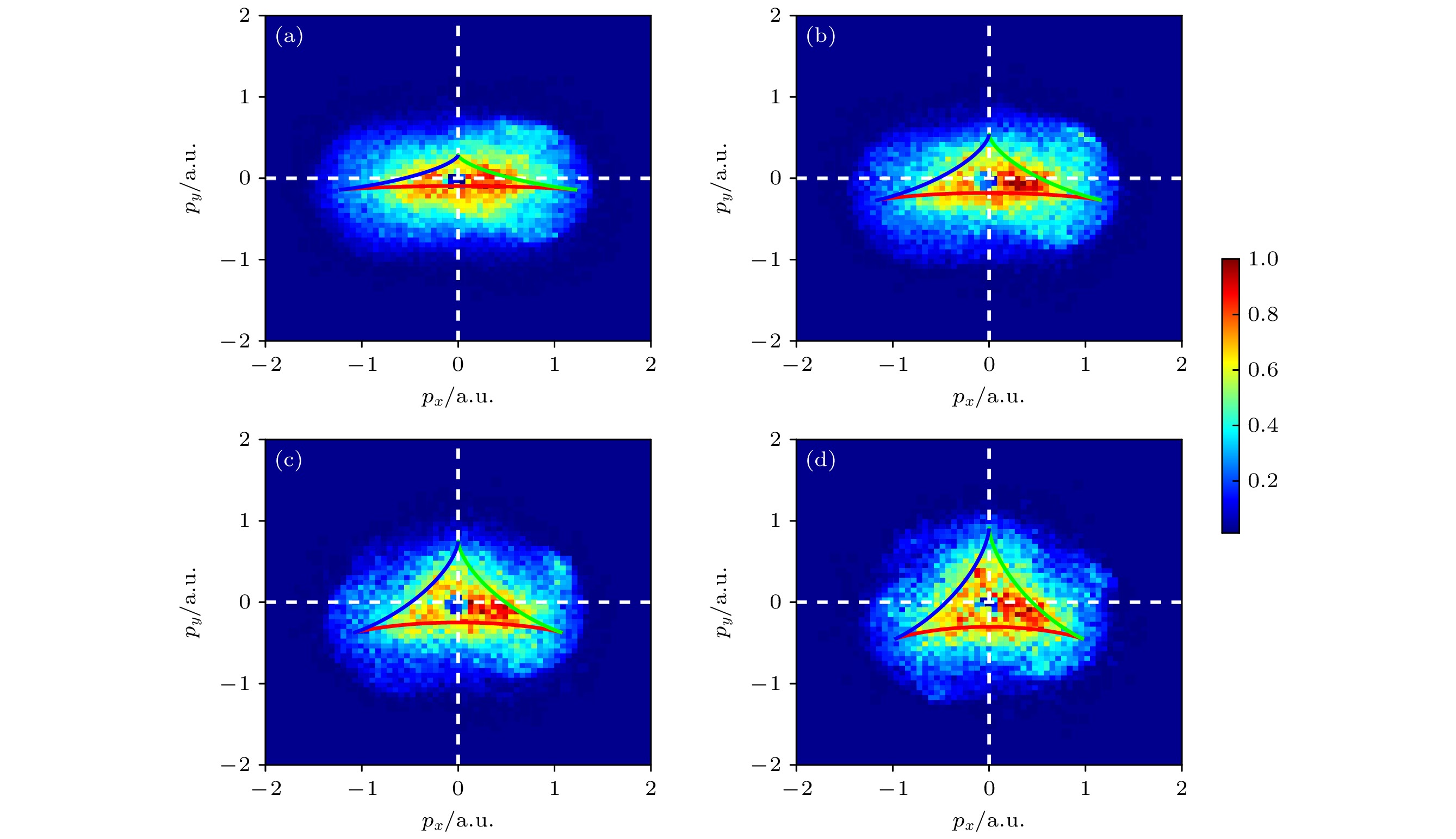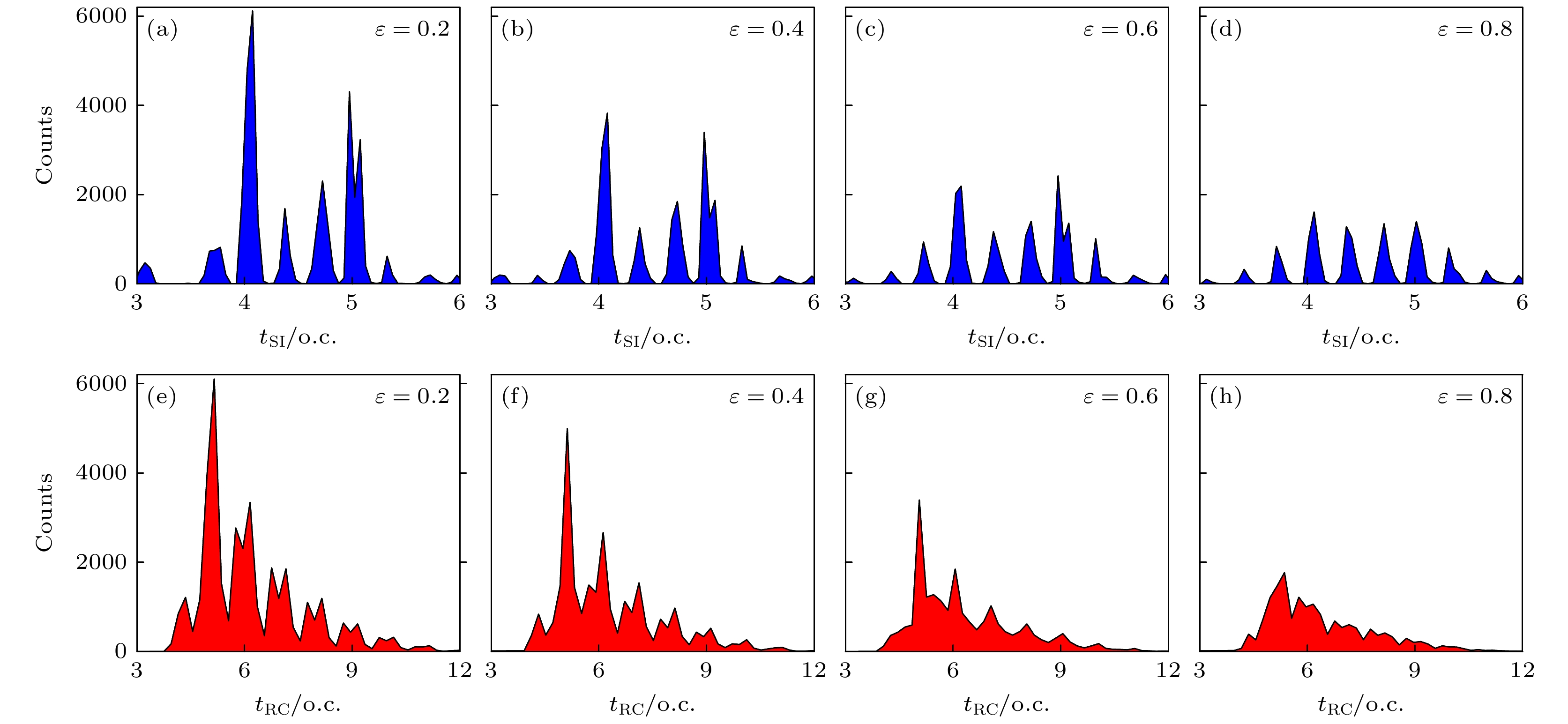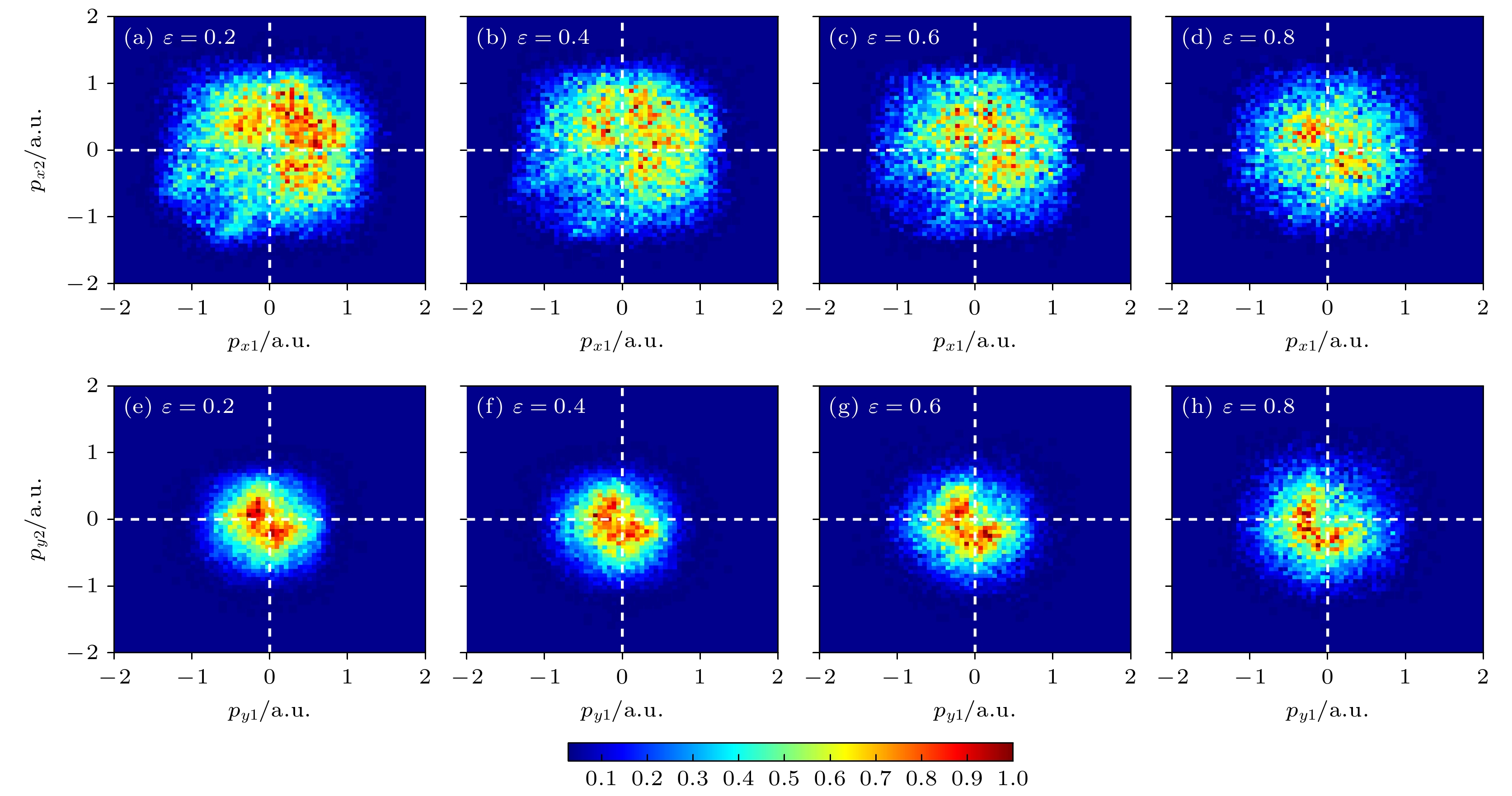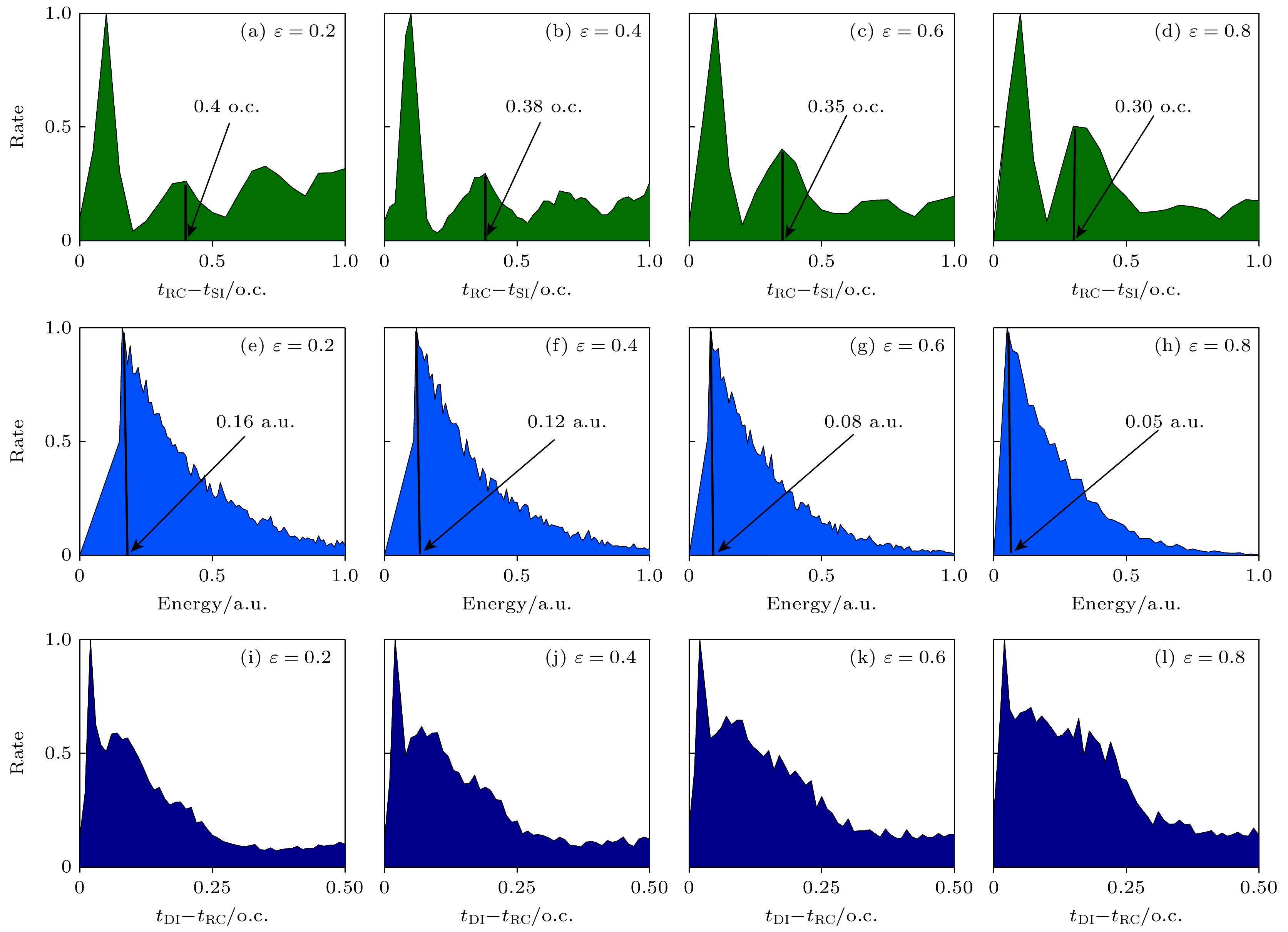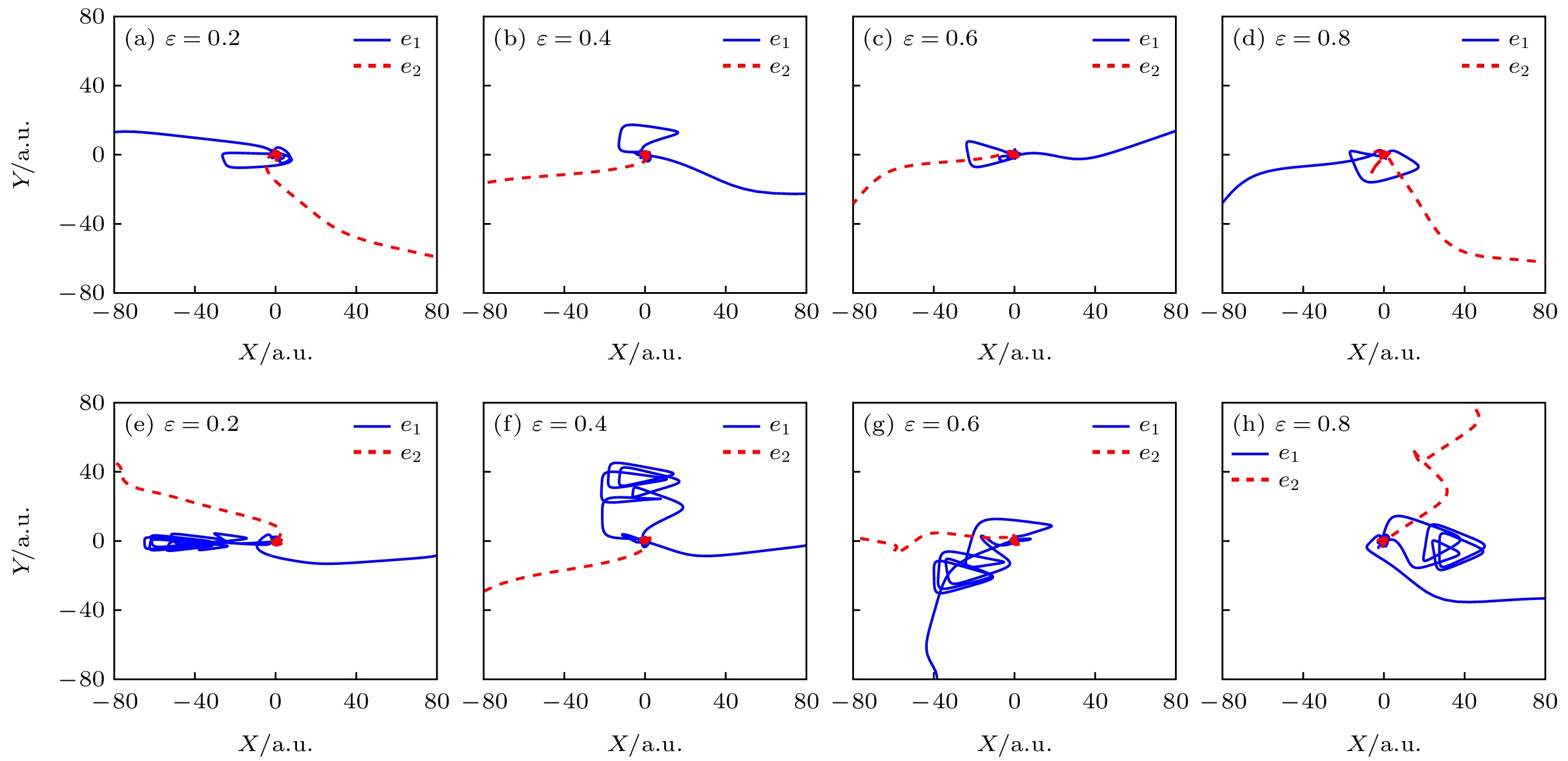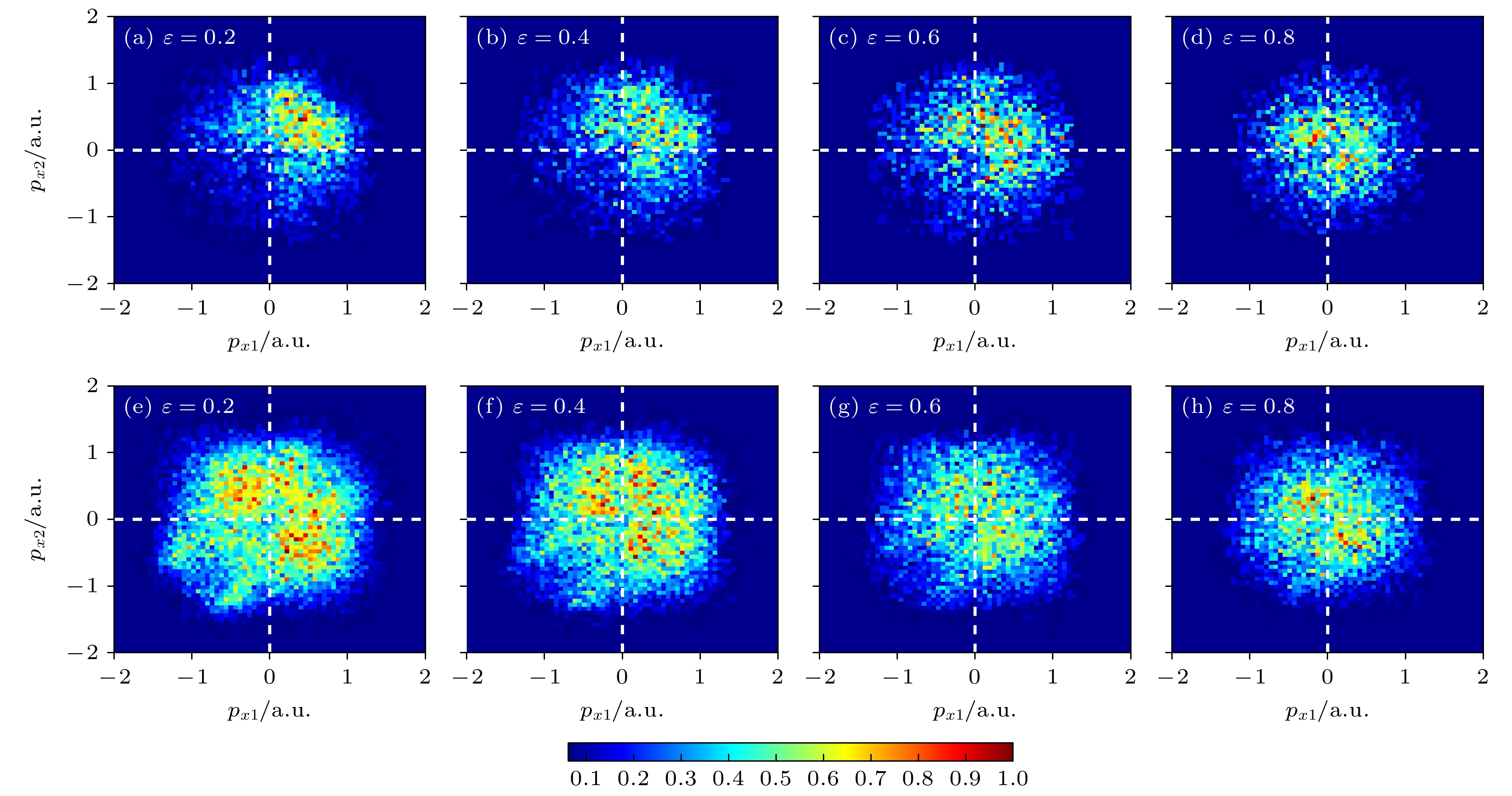-
利用经典系综方法研究了不同椭偏率的反旋双色椭圆偏振(two-color elliptically polarized, TCEP)激光场中Ar原子非序列双电离(nonsequential double ionization, NSDI)的电子关联特性和再碰撞动力学. 不同于反旋双色圆偏振激光场, 反旋TCEP激光场不再具有空间对称性, 返回电子主要从一个方向返回母离子, 从而导致电子动量分布表现出很强的不对称性. 数值结果显示随着椭偏率的增大, Ar原子NSDI的产量逐渐减小, 并且电子对在椭圆偏振激光场长轴方向上的关联电子动量分布, 从主要位于第一和第三象限的正相关逐渐演变为主要位于第二和第四象限的反相关. 通过对不同特征时间的统计分析表明, 随着椭偏率的增大, 旅行时间和返回电子的重碰撞能量逐渐减小, 而延迟时间却增大, 这是电子对关联特性发生变化的主要原因. 此外, 进一步分析发现, 无论是“短轨迹”还是“长轨迹”, 椭偏率的增大都会使两个电子由同向出射逐渐转变为反向出射, 这表明椭偏率和旅行时间都影响着电子的出射方向.
-
关键词:
- 反旋双色椭圆偏振激光场 /
- 非序列双电离 /
- 椭偏率 /
- 电子关联
Electron correlation behaviors and recollision dynamics in nonsequential double ionization (NSDI) of Ar atoms in counter-rotating two-color elliptically polarized (TCEP) laser fields are investigated by using the classical ensemble model. The combined electric field in counter-rotating TCEP laser pulses traces out a trefoil pattern, i.e. the waveform in a period shows three leaves in different directions, and each leaf is called a lobe. Unlike counter-rotating two-color circularly polarized laser field, the combined electric field has no spatial symmetry. The amplitudes of the three field lobes and the angles between them are different. Thus, the returning electron mainly returns to the parent ion from one direction, and the electron momentum distributions show strong asymmetry. Numerical results show that the NSDI yield gradually decreases as the ellipticity increases, and the correlated behavior of the correlated electron momentum along the long axis of the laser polarization plane gradually evolves from correlation behavior mainly located in the first quadrant and the third quadrant to anti-correlation behavior mainly located in the second quadrant and fourth quadrant. In order to further understand the correlation behaviors of electron pairs, different characteristic times in the NSDI processes are discussed, respectively. It is found that single ionization events and recollision events gradually decrease, but single ionization time and recollision time change slightly. This may be the main reason for the decrease in NSDI yield. And as the ellipticity increases, the traveling time and the recollision energy gradually decrease, while the delay time increases. Therefore, we can conclude that ellipticity may be responsible for the NSDI process. In addition, further analysis finds that the shape of the trajectory becomes more and more triangular as the ellipticity increases due to the counter-rotating TCEP laser fields of the specific dynamical symmetries of the total net electric field. And it is found that whether it is a “short trajectory” or a “long trajectory”, more populations move to the second quadrant and the fourth quadrant as the ellipticity increases. The results show that increasing the ellipticity will gradually change the two electrons from emitting in the same direction to emitting in the opposite direction. This well demonstrates that both ellipticity and travelling time are responsible for the formation of the electron momentum distribution at the recollision time, meaning that both of them affect the emitted directions of both electrons.-
Keywords:
- counter-rotating two-color elliptically polarized laser fields /
- nonsequential double ionization /
- ellipticity /
- electron correlation
[1] Sun F, Wei D, Zhang G Z, Ding X, Yao J Q 2016 Chin. Phys. Lett. 33 123202
 Google Scholar
Google Scholar
[2] Chen Y J, Yu S G, Sun R P, Gong C, Hua L Q, Lai X Y, Quan W, Liu X J 2016 Chin. Phys. Lett. 33 043301
 Google Scholar
Google Scholar
[3] Paulus G G, Nicklich W, Xu H L, Lambropoulos P, Walther H 1994 Phys. Rev. Lett. 72 2851
 Google Scholar
Google Scholar
[4] Agostini P, Fabre F, Mainfray G, Petite G, Rahman N K 1979 Phys. Rev. Lett. 42 1127
 Google Scholar
Google Scholar
[5] Milošević D B, Paulus G G, Becker W 2003 Opt. Express 11 1418
 Google Scholar
Google Scholar
[6] He M R, Li Y, Zhou Y M, Li M, Cao W, Lu P X 2018 Phys. Rev. Lett. 120 133204
 Google Scholar
Google Scholar
[7] Zhou Y M, Tolstikhin O I, Morishita T 2016 Phys. Rev. Lett. 116 173001
 Google Scholar
Google Scholar
[8] Lein M, Hay N, Velotta R, Marangos J P, Knight P L 2002 Phys. Rev. Lett. 88 183903
 Google Scholar
Google Scholar
[9] Ghimire S, Reis D A 2019 Nat. Phys. 15 10
 Google Scholar
Google Scholar
[10] Peng M, Bai L, Guo Z 2021 Commun. Theor. Phys. 73 075501
 Google Scholar
Google Scholar
[11] Fittinghoff D N, Bolton P R, Chang B, Kulander K C 1992 Phys. Rev. Lett. 69 2642
 Google Scholar
Google Scholar
[12] Walker B, Sheehy B, DiMauro L F, Agostini P, Schafer K J, Kulander K C 1994 Phys. Rev. Lett. 73 1227
 Google Scholar
Google Scholar
[13] Li H Y, Wang B B, Chen J, Jiang H B, Li X F, Liu J, Gong Q H, Yan Z C, Fu P M 2007 Phys. Rev. A 76 033405
 Google Scholar
Google Scholar
[14] Becker W, Liu X J, Ho P J, Eberly J H 2012 Rev. Mod. Phys. 84 1011
 Google Scholar
Google Scholar
[15] Li Y B, Qin L L, Liu A H, Zhang K, Tang Q B, Zhai C Y, Xu J K, Chen S, Yu B H, Chen J 2022 Chin. Phys. Lett. 39 093201
 Google Scholar
Google Scholar
[16] Ben S, Wang T, Xu T T, Guo J, Liu X S 2016 Opt. Express 24 7525
 Google Scholar
Google Scholar
[17] Ye D F, Liu J 2010 Phys. Rev. A 81 043402
 Google Scholar
Google Scholar
[18] Bergues B, Kübel M, Johnson N G, Fischer B, Camus N, Betsch K J, Herrwerth O, Senftleben A, Sayler A M, Rathje T, Pfeifer T, Ben-Itzhak I, Jones R R, Paulus G G, Krausz F, Moshammer R, Ullrich J, Kling M F 2012 Nat. Commun. 3 813
 Google Scholar
Google Scholar
[19] Ye D, Li M, Fu L B, Liu J, Gong Q H, Liu Y Q, Ullrich J 2015 Phys. Rev. Lett. 115 123001
 Google Scholar
Google Scholar
[20] Kulander K C, Cooper J, Schafer K J 1995 Phys. Rev. A 51 561
 Google Scholar
Google Scholar
[21] Corkum P B 1993 Phys. Rev. Lett. 71 1994
 Google Scholar
Google Scholar
[22] Chen J H, Xu T T, Han T, Sun Y, Xu Q Y, Liu X S 2020 Chin. Phys. B 29 013203
 Google Scholar
Google Scholar
[23] Huang C, Zhou Y M, Zhang Q B, Lu P X 2013 Opt. Express 21 11382
 Google Scholar
Google Scholar
[24] Wang X, Eberly J H 2010 Phys. Rev. Lett. 105 083001
 Google Scholar
Google Scholar
[25] Chen Z J, Liang Y Q, Lin C D 2010 Phys. Rev. Lett. 104 253201
 Google Scholar
Google Scholar
[26] Hao X L, Wang G Q, Jia X Y, Li W D, Liu J, Chen J 2009 Phys. Rev. A 80 023408
 Google Scholar
Google Scholar
[27] Gillen G D, Walker M A, Van Woerkom L D 2001 Phys. Rev. A 64 043413
 Google Scholar
Google Scholar
[28] Li Y, Feng L Q, Qiao Y 2019 Chem. Phys. 527 110497
 Google Scholar
Google Scholar
[29] Xu C Y, Feng L Q, Qiao Y, Li Y 2020 Eur. Phys. J. D 74 139
 Google Scholar
Google Scholar
[30] Eckart S, Richter M, Kunitski M, Hartung A, Rist J, Henrichs K, Schlott N, Kang H, Bauer T, Sann H, Schmidt L P H, Schöffler M, Jahnke T, Dörner R 2016 Phys. Rev. Lett. 117 133202
 Google Scholar
Google Scholar
[31] Mancuso C A, Dorney K M, Dorney D D, Chaloupka J L, Ellis J L, Dollar F J, Knut R, Grychtol P, Zusin D, Gentry C, Gopalakrishnan M, Kapteyn H C, Murnane M M 2016 Phys. Rev. Lett. 117 133201
 Google Scholar
Google Scholar
[32] Chaloupka J L, Hickstein D D 2016 Phys. Rev. Lett. 116 143005
 Google Scholar
Google Scholar
[33] Huang C, Zhong M M, Wu Z M 2018 Opt. Express 26 26045
 Google Scholar
Google Scholar
[34] Eichmann H, Egbert A, Nolte S, Momma C, Wellegehausen B, Becker W, Long S, McIver J K 1995 Phys. Rev. A 51 R3414
 Google Scholar
Google Scholar
[35] Li B Q, Yang X, Ren X H, Zhang J T 2019 Opt. Express 27 32700
 Google Scholar
Google Scholar
[36] Peng M, Bai L H 2020 Chin. Opt. Lett. 18 110201
 Google Scholar
Google Scholar
[37] Su J, Liu Z C, Liao J Y, Huang X F, Li Y B, Huang C 2022 Opt. Express 30 24898
 Google Scholar
Google Scholar
[38] 苏杰, 刘子超, 廖健颖, 李盈傧, 黄诚 2022 物理学报 71 193201
 Google Scholar
Google Scholar
Su, J, Liu Z C, Liao J Y, Li Y B, Huang C 2022 Acta Phys. Sin. 71 193201
 Google Scholar
Google Scholar
[39] Xu T T, Chen J H, Pan X F, Zhang H D, Ben S, Liu X S 2018 Chin. Phys. B 27 093201
 Google Scholar
Google Scholar
[40] Gazibegović-Busuladži A, Busuladžić M, Čerkić A, Hasović E, Becker W, Milošević D B 2019 J. Phys. Conf. Ser. 1206 012003
 Google Scholar
Google Scholar
[41] Milošević D B, Becker W 2020 Phys. Rev. A 102 023107
 Google Scholar
Google Scholar
[42] Ho P J, Panfili R, Haan S L, Eberly J H 2005 Phys. Rev. Lett. 94 093002
 Google Scholar
Google Scholar
[43] Haan S L, Breen L, Karim A, Eberly J H 2006 Phys. Rev. Lett. 97 103008
 Google Scholar
Google Scholar
[44] Zhou Y M, Liao Q, Lu P X 2010 Phys. Rev. A 82 053402
 Google Scholar
Google Scholar
[45] 辛国国, 叶地发, 赵清, 刘杰 2011 物理学报 60 093204
 Google Scholar
Google Scholar
Xin G G, Ye D F, Zhao Q, Liu J 2011 Acta Phys. Sin. 60 093204
 Google Scholar
Google Scholar
[46] Ben S, Guo P Y, Pan X F, Xu T T, Song K L, Liu X S 2017 Chem. Phys. Lett. 679 38
 Google Scholar
Google Scholar
[47] Lin K, Jia X Y, Yu Z Q, He F, Ma J Y, Li H, Gong X C, Song Q Y, Ji Q Y, Zhang W B, Li H X, Lu P F, Zeng H P, Chen J, Wu J 2017 Phys. Rev. Lett. 119 203202
 Google Scholar
Google Scholar
[48] Zhu Q Y, Xu T T, Ben S, Chen J H, Song K L, Liu X S 2018 Opt. Commun. 426 602
 Google Scholar
Google Scholar
-
图 1 (a)—(d)不同椭偏率下, 反旋TCEP激光场的电场结构和负矢势曲线, 三瓣代表电场结构, 三角形代表反旋TCEP激光场的负矢势; (e)对于不同椭偏率的反旋TCEP激光场下, Ar原子随激光强度变化的双电离产量曲线
Fig. 1. (a)–(d) Electric field structure and negative vector potential curve of counter-rotating TCEP laser fields for different ellipticities. The three lobes represent the electric field structure, and the triangle structure represents the negative vector potential of the counter-rotating TCEP laser field. (e) The yield of NSDI for Ar as a function of laser intensity in counter-rotating TCEP laser fields for different ellipticities.
图 2 不同椭偏率的反旋TCEP激光场中电子动量分布(实线为反旋TCEP激光场的负矢势$ - {\boldsymbol A}(t)$) (a) $\varepsilon = 0.2$; (b) $\varepsilon = 0.4$; (c) $\varepsilon = 0.6$; (d) $\varepsilon = 0.8$
Fig. 2. Momentum distributions at different ellipticities in counter-rotating TCEP laser fields: (a) $\varepsilon = 0.2$; (b) $\varepsilon = 0.4$; (c) $\varepsilon = $$ 0.6$; (d) $\varepsilon = 0.8$. The solid line represents the negative vector potential $ - {\boldsymbol A}(t)$of counter-rotating TCEP laser fields.
图 3 (a)—(d)不同椭偏率下, Ar原子单电离时刻${t_{{\text{SI}}}}$的分布; (e)—(h)不同椭偏率下, Ar原子重碰撞时刻${t_{{\text{RC}}}}$的分布
Fig. 3. (a)–(d) Statistical distribution of the single ionization time ${t_{{\text{SI}}}}$ for Ar atoms with different ellipticities; (e)–(h) statistical distribution of the electron recollision time ${t_{{\text{RC}}}}$ for Ar atoms with different ellipticities.
图 5 (a)—(d)不同椭偏率下, Ar原子旅行时间(${t_{{\text{RC}}}} - {t_{{\text{SI}}}}$)的分布; (e)—(h)不同椭偏率下, 返回电子重碰撞能量的分布; (i)—(l)不同椭偏率下, Ar原子延迟时间(${t_{{\text{DI}}}} - {t_{{\text{RC}}}}$)的分布
Fig. 5. (a)–(d) Statistical distribution of the traveling time (${t_{{\text{RC}}}} - {t_{{\text{SI}}}}$) for Ar atoms with different ellipticities; (e)–(h) distributions of the returning electron recollision energy with different ellipticities; (i)–(l) statistical distribution of the delay time $({t_{{\text{DI}}}} - {t_{{\text{RC}}}}$) for Ar atoms with different ellipticities.
图 6 不同椭偏率的反旋TCEP激光场中两个电子轨迹 (a)—(d) 上面一行是“短轨迹”( ${t_{{\text{RC}}}} - {t_{{\text{SI}}}} < 0.2 \;{\text{o}}{\text{.c}}{.}$)的电子轨迹; (e)—(h)下面一行是“长轨迹”( ${t_{{\text{RC}}}} - {t_{{\text{SI}}}} \geqslant 0.2\; {\text{o}}{\text{.c}}{.}$)的电子轨迹
Fig. 6. Trajectory of the two electrons at different ellipticities in counter-rotating TCEP laser fields: (a)–(d) The top row shows trajectories of the ionized electron coming back to the parent ion core with the “short trajectory” (${t_{{\text{RC}}}} - {t_{{\text{SI}}}} < 0.2 \;{\text{o}}{\text{.c}}{.}$); (e)–(h) the bottom row shows trajectories of the ionized electron coming back to the parent ion core with the “long trajectory” $({t_{{\text{RC}}}} - {t_{{\text{SI}}}} \geqslant 0.2\; {\text{o}}{\text{.c}}{.}$).
图 7 不同椭偏率下, 两个电子在x方向上的关联电子动量分布 (a)—(d)上面一行是“短轨迹”( ${t_{{\text{RC}}}} - {t_{{\text{SI}}}} < 0.2\; {\text{o}}{\text{.c}}{.}$)的关联电子动量分布; (e)—(h)下面一行是“长轨迹”( ${t_{{\text{RC}}}} - {t_{{\text{SI}}}} \geqslant 0.2\; {\text{o}}{\text{.c}}{.}$)的关联电子动量分布
Fig. 7. Correlated momentum distributions of the electrons in the x direction for different ellipticities: (a)–(d) The top row shows correlated momentum distributions with the “short trajectory” (${t_{{\text{RC}}}} - {t_{{\text{SI}}}} < 0.2 \;{\text{o}}{\text{.c}}{.}$); (e)–(h) the bottom row shows correlated momentum distributions with the “long trajectory”(${t_{{\text{RC}}}} - {t_{{\text{SI}}}} \geqslant 0.2\; {\text{o}}{\text{.c}}{.}$).
-
[1] Sun F, Wei D, Zhang G Z, Ding X, Yao J Q 2016 Chin. Phys. Lett. 33 123202
 Google Scholar
Google Scholar
[2] Chen Y J, Yu S G, Sun R P, Gong C, Hua L Q, Lai X Y, Quan W, Liu X J 2016 Chin. Phys. Lett. 33 043301
 Google Scholar
Google Scholar
[3] Paulus G G, Nicklich W, Xu H L, Lambropoulos P, Walther H 1994 Phys. Rev. Lett. 72 2851
 Google Scholar
Google Scholar
[4] Agostini P, Fabre F, Mainfray G, Petite G, Rahman N K 1979 Phys. Rev. Lett. 42 1127
 Google Scholar
Google Scholar
[5] Milošević D B, Paulus G G, Becker W 2003 Opt. Express 11 1418
 Google Scholar
Google Scholar
[6] He M R, Li Y, Zhou Y M, Li M, Cao W, Lu P X 2018 Phys. Rev. Lett. 120 133204
 Google Scholar
Google Scholar
[7] Zhou Y M, Tolstikhin O I, Morishita T 2016 Phys. Rev. Lett. 116 173001
 Google Scholar
Google Scholar
[8] Lein M, Hay N, Velotta R, Marangos J P, Knight P L 2002 Phys. Rev. Lett. 88 183903
 Google Scholar
Google Scholar
[9] Ghimire S, Reis D A 2019 Nat. Phys. 15 10
 Google Scholar
Google Scholar
[10] Peng M, Bai L, Guo Z 2021 Commun. Theor. Phys. 73 075501
 Google Scholar
Google Scholar
[11] Fittinghoff D N, Bolton P R, Chang B, Kulander K C 1992 Phys. Rev. Lett. 69 2642
 Google Scholar
Google Scholar
[12] Walker B, Sheehy B, DiMauro L F, Agostini P, Schafer K J, Kulander K C 1994 Phys. Rev. Lett. 73 1227
 Google Scholar
Google Scholar
[13] Li H Y, Wang B B, Chen J, Jiang H B, Li X F, Liu J, Gong Q H, Yan Z C, Fu P M 2007 Phys. Rev. A 76 033405
 Google Scholar
Google Scholar
[14] Becker W, Liu X J, Ho P J, Eberly J H 2012 Rev. Mod. Phys. 84 1011
 Google Scholar
Google Scholar
[15] Li Y B, Qin L L, Liu A H, Zhang K, Tang Q B, Zhai C Y, Xu J K, Chen S, Yu B H, Chen J 2022 Chin. Phys. Lett. 39 093201
 Google Scholar
Google Scholar
[16] Ben S, Wang T, Xu T T, Guo J, Liu X S 2016 Opt. Express 24 7525
 Google Scholar
Google Scholar
[17] Ye D F, Liu J 2010 Phys. Rev. A 81 043402
 Google Scholar
Google Scholar
[18] Bergues B, Kübel M, Johnson N G, Fischer B, Camus N, Betsch K J, Herrwerth O, Senftleben A, Sayler A M, Rathje T, Pfeifer T, Ben-Itzhak I, Jones R R, Paulus G G, Krausz F, Moshammer R, Ullrich J, Kling M F 2012 Nat. Commun. 3 813
 Google Scholar
Google Scholar
[19] Ye D, Li M, Fu L B, Liu J, Gong Q H, Liu Y Q, Ullrich J 2015 Phys. Rev. Lett. 115 123001
 Google Scholar
Google Scholar
[20] Kulander K C, Cooper J, Schafer K J 1995 Phys. Rev. A 51 561
 Google Scholar
Google Scholar
[21] Corkum P B 1993 Phys. Rev. Lett. 71 1994
 Google Scholar
Google Scholar
[22] Chen J H, Xu T T, Han T, Sun Y, Xu Q Y, Liu X S 2020 Chin. Phys. B 29 013203
 Google Scholar
Google Scholar
[23] Huang C, Zhou Y M, Zhang Q B, Lu P X 2013 Opt. Express 21 11382
 Google Scholar
Google Scholar
[24] Wang X, Eberly J H 2010 Phys. Rev. Lett. 105 083001
 Google Scholar
Google Scholar
[25] Chen Z J, Liang Y Q, Lin C D 2010 Phys. Rev. Lett. 104 253201
 Google Scholar
Google Scholar
[26] Hao X L, Wang G Q, Jia X Y, Li W D, Liu J, Chen J 2009 Phys. Rev. A 80 023408
 Google Scholar
Google Scholar
[27] Gillen G D, Walker M A, Van Woerkom L D 2001 Phys. Rev. A 64 043413
 Google Scholar
Google Scholar
[28] Li Y, Feng L Q, Qiao Y 2019 Chem. Phys. 527 110497
 Google Scholar
Google Scholar
[29] Xu C Y, Feng L Q, Qiao Y, Li Y 2020 Eur. Phys. J. D 74 139
 Google Scholar
Google Scholar
[30] Eckart S, Richter M, Kunitski M, Hartung A, Rist J, Henrichs K, Schlott N, Kang H, Bauer T, Sann H, Schmidt L P H, Schöffler M, Jahnke T, Dörner R 2016 Phys. Rev. Lett. 117 133202
 Google Scholar
Google Scholar
[31] Mancuso C A, Dorney K M, Dorney D D, Chaloupka J L, Ellis J L, Dollar F J, Knut R, Grychtol P, Zusin D, Gentry C, Gopalakrishnan M, Kapteyn H C, Murnane M M 2016 Phys. Rev. Lett. 117 133201
 Google Scholar
Google Scholar
[32] Chaloupka J L, Hickstein D D 2016 Phys. Rev. Lett. 116 143005
 Google Scholar
Google Scholar
[33] Huang C, Zhong M M, Wu Z M 2018 Opt. Express 26 26045
 Google Scholar
Google Scholar
[34] Eichmann H, Egbert A, Nolte S, Momma C, Wellegehausen B, Becker W, Long S, McIver J K 1995 Phys. Rev. A 51 R3414
 Google Scholar
Google Scholar
[35] Li B Q, Yang X, Ren X H, Zhang J T 2019 Opt. Express 27 32700
 Google Scholar
Google Scholar
[36] Peng M, Bai L H 2020 Chin. Opt. Lett. 18 110201
 Google Scholar
Google Scholar
[37] Su J, Liu Z C, Liao J Y, Huang X F, Li Y B, Huang C 2022 Opt. Express 30 24898
 Google Scholar
Google Scholar
[38] 苏杰, 刘子超, 廖健颖, 李盈傧, 黄诚 2022 物理学报 71 193201
 Google Scholar
Google Scholar
Su, J, Liu Z C, Liao J Y, Li Y B, Huang C 2022 Acta Phys. Sin. 71 193201
 Google Scholar
Google Scholar
[39] Xu T T, Chen J H, Pan X F, Zhang H D, Ben S, Liu X S 2018 Chin. Phys. B 27 093201
 Google Scholar
Google Scholar
[40] Gazibegović-Busuladži A, Busuladžić M, Čerkić A, Hasović E, Becker W, Milošević D B 2019 J. Phys. Conf. Ser. 1206 012003
 Google Scholar
Google Scholar
[41] Milošević D B, Becker W 2020 Phys. Rev. A 102 023107
 Google Scholar
Google Scholar
[42] Ho P J, Panfili R, Haan S L, Eberly J H 2005 Phys. Rev. Lett. 94 093002
 Google Scholar
Google Scholar
[43] Haan S L, Breen L, Karim A, Eberly J H 2006 Phys. Rev. Lett. 97 103008
 Google Scholar
Google Scholar
[44] Zhou Y M, Liao Q, Lu P X 2010 Phys. Rev. A 82 053402
 Google Scholar
Google Scholar
[45] 辛国国, 叶地发, 赵清, 刘杰 2011 物理学报 60 093204
 Google Scholar
Google Scholar
Xin G G, Ye D F, Zhao Q, Liu J 2011 Acta Phys. Sin. 60 093204
 Google Scholar
Google Scholar
[46] Ben S, Guo P Y, Pan X F, Xu T T, Song K L, Liu X S 2017 Chem. Phys. Lett. 679 38
 Google Scholar
Google Scholar
[47] Lin K, Jia X Y, Yu Z Q, He F, Ma J Y, Li H, Gong X C, Song Q Y, Ji Q Y, Zhang W B, Li H X, Lu P F, Zeng H P, Chen J, Wu J 2017 Phys. Rev. Lett. 119 203202
 Google Scholar
Google Scholar
[48] Zhu Q Y, Xu T T, Ben S, Chen J H, Song K L, Liu X S 2018 Opt. Commun. 426 602
 Google Scholar
Google Scholar
计量
- 文章访问数: 4677
- PDF下载量: 70
- 被引次数: 0













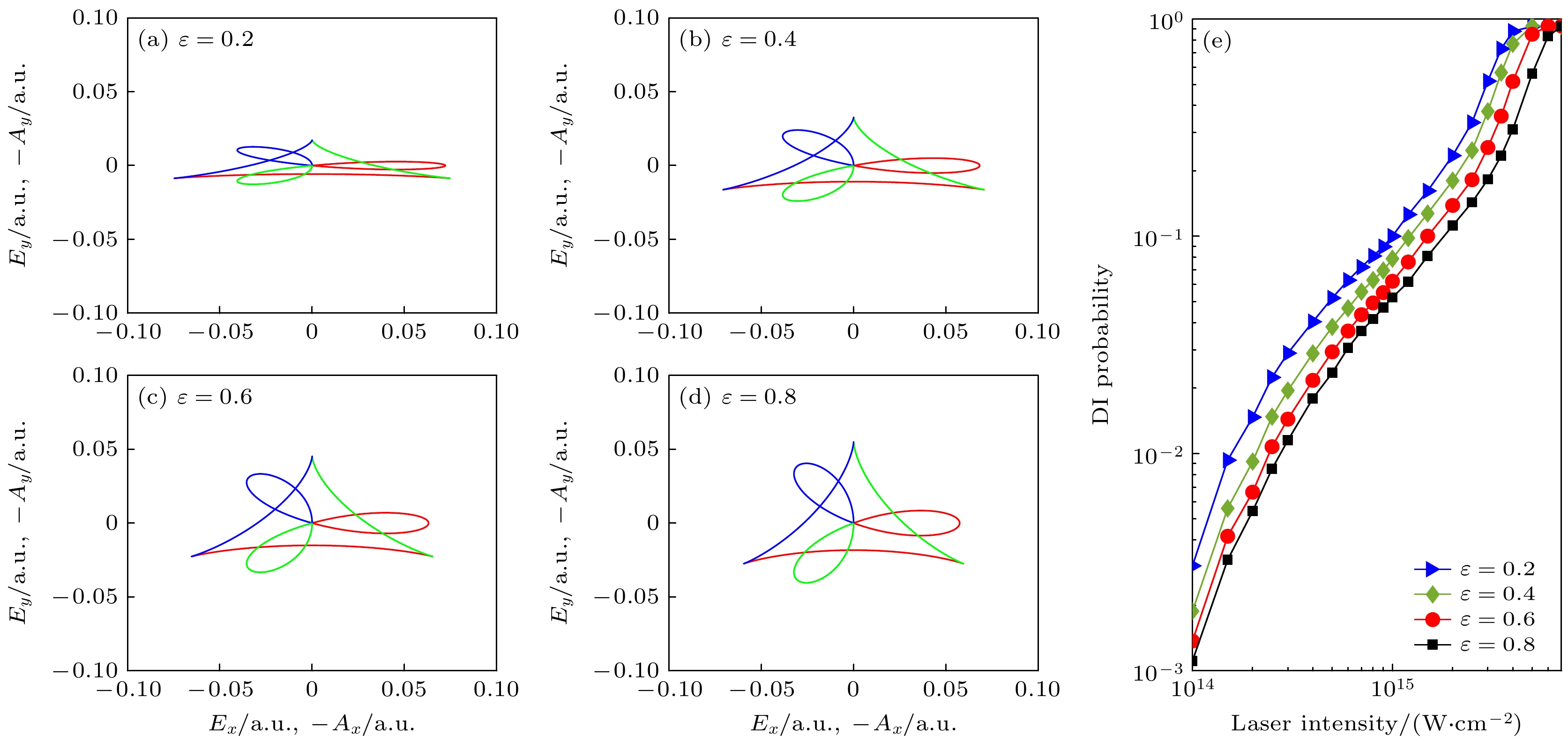
 下载:
下载:
